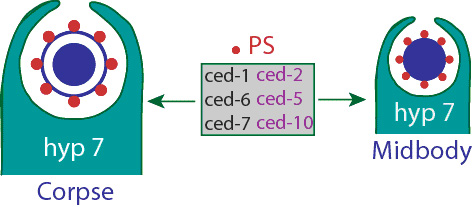IBP scientists discover novel function of cell death genes through Apoptotic mimicry
Midbody is a singular organelle formed between the two nascent daughter cells when a cell divides. Midbody degradation is an important cellular process. Midbody clearance defect is associated with human lysosomal storage disorder. Midbody degradation may also contribute to cell fate determination: daughter cells that remain as stem cells retain their midbodies, whereas those that differentiate degrade or shed the midbodies. However, most of our current knowledge of midbody was obtained from cultured cell lines, and the fate of midbody, in live animals, remains largely unknown.
Recently, Dr. OU Guangshuo’s group at the Institute of Biophysics, Chinese Acadamy of Sciences used C.eleganse Q neuroblast as an in vivo model to study the post-division fate of midbody. Through live imaging analysis they found that midbodies generated by Q cell divisions were released to the extracellular space and subsequently internalized and degraded by the phagocyte that digests apoptotic Q cell corpses.
It has been known that C. elegans apoptotic cells externalize phosphatidylserine (PS) signal to trigger two parallel signaling pathways (CED-1, CED-6 and CED-7; CED-2, CED-5, CED-10 and CED-12) in the phagocyte, which engulfs and degrades apoptotic cell corpses. OU’s group showed that midbody degradation is defective in these apoptotic cell engulfment (ced genes) mutants. Moreover, externalized phosphatidylserine (PS) exists on the outer surface of the midbody, and inhibiting PS signaling delayed midbody clearance.
Dr. OU’s findings describe the fate of Q cell midbodies after abscission in vivo, and expand the non-apoptotic functional repertoire of cell death genes in C. elegans, e.g. mediating internalization and degradation of released midbodies.
Dr. OU’s group published an article on Journal of Cell Biology entitled “Apoptotic regulators promote cytokinetic midbody degradation in C. elegans” to report their findings about the apoptotic mimicry in midbody degradation. Journal of Cell Biologyintroduced Dr. OU’s work in ” In This Issue”; also the editor interviewed Dr. OU and thePodcast of JCB featured the story and interview.
This work was supported by grants from the Ministry of Science and Technology of China, the National Natural Science Foundation of China and Chinese Academy of Sciences.

Figure legend:Apoptotic Mimicry in Midbody Degradation
Article link:http://jcb.rupress.org/content/199/7/1047 ;
In This Issue link: http://jcb.rupress.org/content/199/7/1018.1 ;
Podcast link: http://jcb.rupress.org/content/199/7/1047/suppl/DC2。

